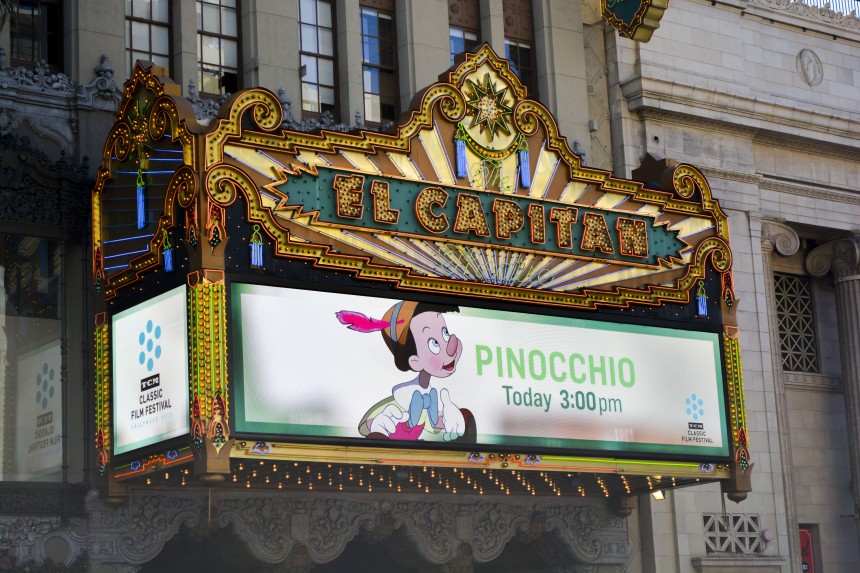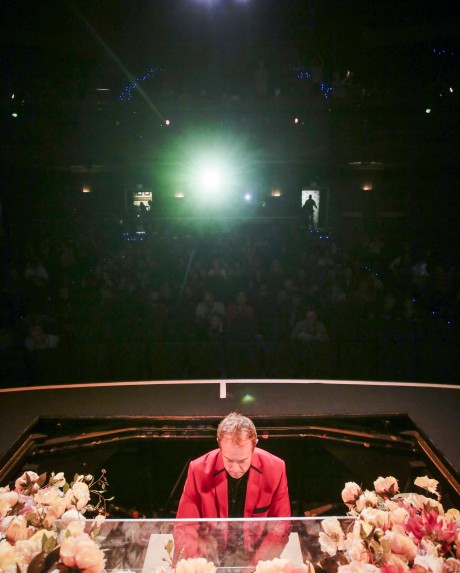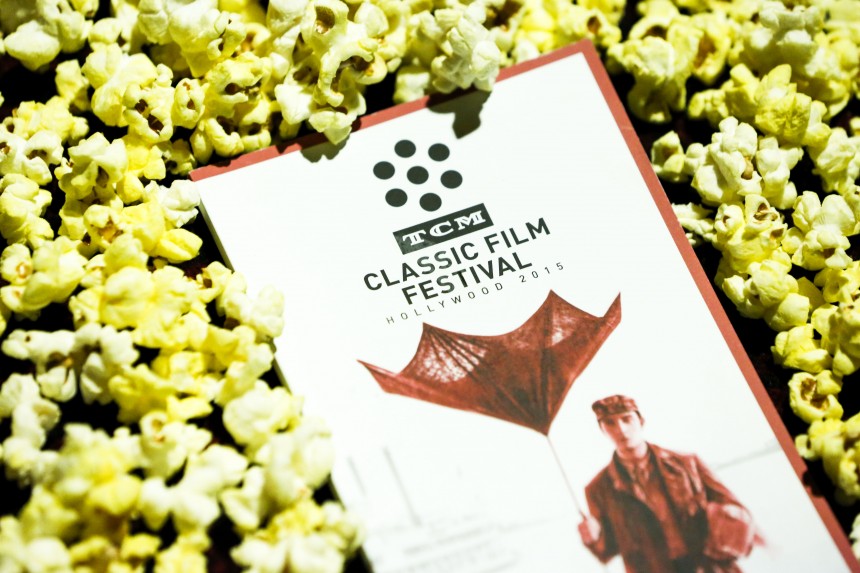Several times a year, Turner Classic Movies hosts a new, on-air showcase of Treasures from the Disney Vault: a wide array of Disney classics for the entire family to enjoy, including animated shorts, feature films, live-action movies, documentaries, nature films, and made-for-television movies. Tune in—or set your recording devices—tomorrow, Thursday, July 2 at 8pm ET, for their summer installment of Disney favorites, including Hawaiian Holiday (1937), Johnny Tremaine (1957), The Great Locomotive Chase (1956), and so many more!
In celebration of this television marathon, we're thrilled to share with you highlights and a recap of the screenings and events that happened during the 2015 TCM Classic Film Festival.
 It is hard to imagine any Disney film, from whatever genre or decade, not falling into the “classic” category. However, in this age of being able to, at any time, personally watch films on apparatus ranging from 5-inch phone screens to gigantic home theaters, the opportunity to see classic Disney movies from decades past on a theater big screen is, unfortunately, still rather rare. Thus, when two timeless masterpieces—Pinocchio and So Dear to My Heart—appeared not only on the “silver screen”, but also at famous Hollywood venues, attended by thousands of passionate Disney aficionados, it was, well, a true treat.
It is hard to imagine any Disney film, from whatever genre or decade, not falling into the “classic” category. However, in this age of being able to, at any time, personally watch films on apparatus ranging from 5-inch phone screens to gigantic home theaters, the opportunity to see classic Disney movies from decades past on a theater big screen is, unfortunately, still rather rare. Thus, when two timeless masterpieces—Pinocchio and So Dear to My Heart—appeared not only on the “silver screen”, but also at famous Hollywood venues, attended by thousands of passionate Disney aficionados, it was, well, a true treat.
 On March 26 to March 29 this year, Turner Classic Movies held its sixth Classic Film Festival in Hollywood, California. Centered at the historic Roosevelt Hotel, with over 100 films, events, and discussions occurring over these jam-packed but exciting days, Disney fans were party to a number of special and meaningful moments. From glimpsing the iconic Julie Andrews strolling the red carpet on her way into the grand TCL—formerly Grauman’s-Chinese Theatre—who, although there to introduce the 50th anniversary edition of The Sound of Music and not appear as our “Mary Poppins,” still touched hearts with her warmth and grace, to hearing TCM’s Senior Vice President of Programming Charlie Tabesh relate the network’s plans to expand their partnership with Disney, it was a memorable, if exhausting, feast for the eyes, mind and soul. Perhaps the most significant experiences, however, were seeing the two featured Disney classics in all their spectacular glory.
On March 26 to March 29 this year, Turner Classic Movies held its sixth Classic Film Festival in Hollywood, California. Centered at the historic Roosevelt Hotel, with over 100 films, events, and discussions occurring over these jam-packed but exciting days, Disney fans were party to a number of special and meaningful moments. From glimpsing the iconic Julie Andrews strolling the red carpet on her way into the grand TCL—formerly Grauman’s-Chinese Theatre—who, although there to introduce the 50th anniversary edition of The Sound of Music and not appear as our “Mary Poppins,” still touched hearts with her warmth and grace, to hearing TCM’s Senior Vice President of Programming Charlie Tabesh relate the network’s plans to expand their partnership with Disney, it was a memorable, if exhausting, feast for the eyes, mind and soul. Perhaps the most significant experiences, however, were seeing the two featured Disney classics in all their spectacular glory.
Although TCM film festival tickets go on sale many months before the gathering, the actual films are not revealed until much later. At previous festivals, however, Disney fans have been fortunate to see Fantasia, introduced by the beloved Diane Disney Miller, Snow White and the Seven Dwarfs, 20,000 Leagues Under the Sea, and Summer Magic attended by its lovely star, Hayley Mills. The ageless Richard Sherman, at the 2014 event, not only walked the red carpet greeting his adoring (including this author) fans, but regaled audiences with stories at the showing of Mary Poppins. As well, film historians such as Leonard Maltin and TCM host Ben Mankiewicz have provided introductions, perspective and analysis of featured Disney films’ perennial appeal, including The Jungle Book and Lady and the Tramp. This year’s line-up did not disappoint. Showing Pinocchio in the Disney-owned and spectacularly restored El Capitan theater and So Dear to My Heart in a newer but technically cutting-edge venue, both films segued nicely with the festival theme, “History According to Hollywood.”
 According to the festival Programming Guide, 1940s Pinocchio originated with Disney animation director Norman Ferguson approaching Walt Disney with a copy of Carlo Collodi’s children’s book of the same name. Just finishing 1937s Snow White and the Seven Dwarfs, Walt became interested in the tale of a puppet brought to life as a real boy. This film marked a series of first-time events for Disney, including using vaudeville and radio star Cliff Edwards as the voice of Jiminy Cricket, and as the first film to win Academy Awards® for both Best Song, “When You Wish Upon a Star,” and Best Original Score. Pinocchio utilized the Multiplane Camera, giving the scenes and characters depth and more life-like qualities. In years since, strategically timed re-releases of the film have made it a lucrative one for the Studios, grossing more than $80 million and its appeal has lost nothing across generations. Perhaps its most lasting legacy, however, has been its theme song, which was not just a personal favorite of Walt’s, but continues to waft through Disney Parks & Resorts to this day, often as a part of spectacular displays.
According to the festival Programming Guide, 1940s Pinocchio originated with Disney animation director Norman Ferguson approaching Walt Disney with a copy of Carlo Collodi’s children’s book of the same name. Just finishing 1937s Snow White and the Seven Dwarfs, Walt became interested in the tale of a puppet brought to life as a real boy. This film marked a series of first-time events for Disney, including using vaudeville and radio star Cliff Edwards as the voice of Jiminy Cricket, and as the first film to win Academy Awards® for both Best Song, “When You Wish Upon a Star,” and Best Original Score. Pinocchio utilized the Multiplane Camera, giving the scenes and characters depth and more life-like qualities. In years since, strategically timed re-releases of the film have made it a lucrative one for the Studios, grossing more than $80 million and its appeal has lost nothing across generations. Perhaps its most lasting legacy, however, has been its theme song, which was not just a personal favorite of Walt’s, but continues to waft through Disney Parks & Resorts to this day, often as a part of spectacular displays.
Introducing the movie at the festival, film-maker Brandon Oldenburg related that Pinocchio was not meant to be a “cartoon” but rather a film. It pushed the boundaries of animation at that time and he opined it is the “greatest animated film of all time.” His co-introducer, William Joyce, a film-maker and author, also emphasized that the hand-drawn quality of the film makes it a rare and special treat for viewers. Indeed, as the Programming Guide noted, Pinocchio has influenced animators for decades and remains a visual and visceral spectacle.
 In the opulence of the El Capitan theater, with the organ rising majestically from the floor below, and the strains of “When You Wish Upon a Star” playing pre-film, the theater was packed with film enthusiasts who applauded as the film opened, and sniffled as emotional scenes played. One of the constants at the TCM film festival is the appreciation shown by fans throughout the films, clapping as credits roll and cheering as it ends. For this viewer, never having seen the film on the big screen before, the colors, the details, and the seamless accompanying music created an unforgettable and rich experience. The genius that was Walt Disney at this, a still early point in his career, is so beautifully executed. The artistic talents of Walt’s “Nine Old Men,” including Ollie Johnston, Frank Thomas and Ward Kimball, are on lush and dramatic display. Although one is always touched by Pinocchio at many levels, it is not an overstatement to say that the audience who had this rare and wonderful opportunity left much moved and enchanted by seeing the film as it was meant to be shown.
In the opulence of the El Capitan theater, with the organ rising majestically from the floor below, and the strains of “When You Wish Upon a Star” playing pre-film, the theater was packed with film enthusiasts who applauded as the film opened, and sniffled as emotional scenes played. One of the constants at the TCM film festival is the appreciation shown by fans throughout the films, clapping as credits roll and cheering as it ends. For this viewer, never having seen the film on the big screen before, the colors, the details, and the seamless accompanying music created an unforgettable and rich experience. The genius that was Walt Disney at this, a still early point in his career, is so beautifully executed. The artistic talents of Walt’s “Nine Old Men,” including Ollie Johnston, Frank Thomas and Ward Kimball, are on lush and dramatic display. Although one is always touched by Pinocchio at many levels, it is not an overstatement to say that the audience who had this rare and wonderful opportunity left much moved and enchanted by seeing the film as it was meant to be shown.
Additionally, the choice of featuring 1949s So Dear To My Heart perfectly matched this year’s festival theme regarding history. The programming guide explained that this film was one of Walt Disney’s most personal tales, drawing deeply from his own child hood in turn of the twentieth century rural Missouri. The movie is based upon the 1943 children’s novel Midnight and Jeremiah by Sterling North, and was intended to be Disney’s first full-length live-action film. However, when executives with RKO pictures—which released Disney films at the time—learned this, they argued that without some animation, they couldn’t “sell” the picture. Relenting—much to audiences’ delight since—Walt included a few animated characters, sprung from the young protagonist’s imagination. Indeed, this tale of young Jeremiah, growing up on an Indiana farm with his grandmother, mirrors the idyllic adventures Walt himself experienced, including communing with the natural world while learning life lessons. The film was the first of Disney’s to be shot on location, in the San Joaquin valley, with sets built there including a hardware store packed with items found by the crew at a previously shuttered establishment. Walt “dear”ly loved this film, and it was so meaningful to him, he had the barn set re-created on his own property. Also, the film’s railroad station served as the model for the Frontierland stop in Disneyland. The Oscar®-nominated song, “Lavender Blue (Dilly, Dilly),” sung by the incomparable Burl Ives, became a hit single, expressing the film’s message of simple beauty found in nature.
Noted Disney historian Leonard Maltin introduced the film at the TCM festival, highlighting its innovation as Disney’s first, and somewhat risky, foray from animation into live-action. Stars Bobby Driscoll and Luanna Patton were under contract to Disney at the time, and fit nicely into their roles (the first of several they played together, including 1946s Song of the South) as young Jeremiah and his cousin Tildy. By employing storyboards in drafting the film, Walt utilized a method that had served well in previous animated features and would continue as a mechanism for development in future projects.
 It was the first time much of the audience, including the author, had seen the film and it delighted in every way. From the accurate settings of turn of the century rural America, to the simple pleasures found in country life, the film is a warm and affectionate depiction. The viewers were deeply affected by this picture, from its simple story to its profound lessons. It is a time now long gone, but one that formed the foundation of not just the American way of life, but Walt Disney’s personal value system. The notions of hard work, acceptance, family and love are displayed in a manner that is both nostalgic and timeless. This time period, which forms the basis for Disneyland's Main Street, U.S.A. areas, enraptures viewers with its simplicity and old-fashioned standards. As Walt himself said in his Disneyland opening day speech in 1955, standing on Main Street, U.S.A., “…here age relives fond memories of the past…Disneyland is dedicated to the ideals, the dreams and the hard facts that have created America.” So Dear To My Heart paints this time and its moral lessons across the screen and into viewers’ hearts.
It was the first time much of the audience, including the author, had seen the film and it delighted in every way. From the accurate settings of turn of the century rural America, to the simple pleasures found in country life, the film is a warm and affectionate depiction. The viewers were deeply affected by this picture, from its simple story to its profound lessons. It is a time now long gone, but one that formed the foundation of not just the American way of life, but Walt Disney’s personal value system. The notions of hard work, acceptance, family and love are displayed in a manner that is both nostalgic and timeless. This time period, which forms the basis for Disneyland's Main Street, U.S.A. areas, enraptures viewers with its simplicity and old-fashioned standards. As Walt himself said in his Disneyland opening day speech in 1955, standing on Main Street, U.S.A., “…here age relives fond memories of the past…Disneyland is dedicated to the ideals, the dreams and the hard facts that have created America.” So Dear To My Heart paints this time and its moral lessons across the screen and into viewers’ hearts.
Always hoping for more of Disney fare both on the Turner Classic Movies channel, as well as at upcoming film festivals, TCM’s Charlie Tabesh was asked what’s in store for the future. He responded that “We [TCM] have developed an incredible partnership with Disney and, over the years we have wanted to dive into the Disney franchise.” With recent strengthening of this relationship, Tabesh indicated that more Disney fare is expected. In recent months, not only have Disney films been featured on the channel, but documentary programming has included The Disneyland Story and Walt and El Grupo, among others. Since, at least in this author’s opinion, there is no such thing as “too much” Disney, this, indeed, is welcome and encouraging news both for us as Disney devotees, and for classic movies fans everywhere.
The 2015 TCM Classic Film Festival provided a wonderful opportunity to indulge a passion for presentation and preservation of Disney films as well as see Walt’s legacy of timeless and valued entertainment so beautifully appreciated. As to more of the same in the future through Turner Classic Movies…well, perhaps if we “wish upon a star” (and encouragingly share our enthusiasm with TCM directly) this dream will, indeed, come true!

Thomas Price is a junior at the University of Colorado, Colorado Springs, where he’s majoring in History and minoring in both Film Studies and Museum Studies. His business card lists his occupation as “Disney Scholar,” noting his volunteer work at the WDFM; dramatic and educational portrayals of Walt; university teaching assistance in Walt Disney-focused courses; and, as indicated here, writing for the Museum blog.
